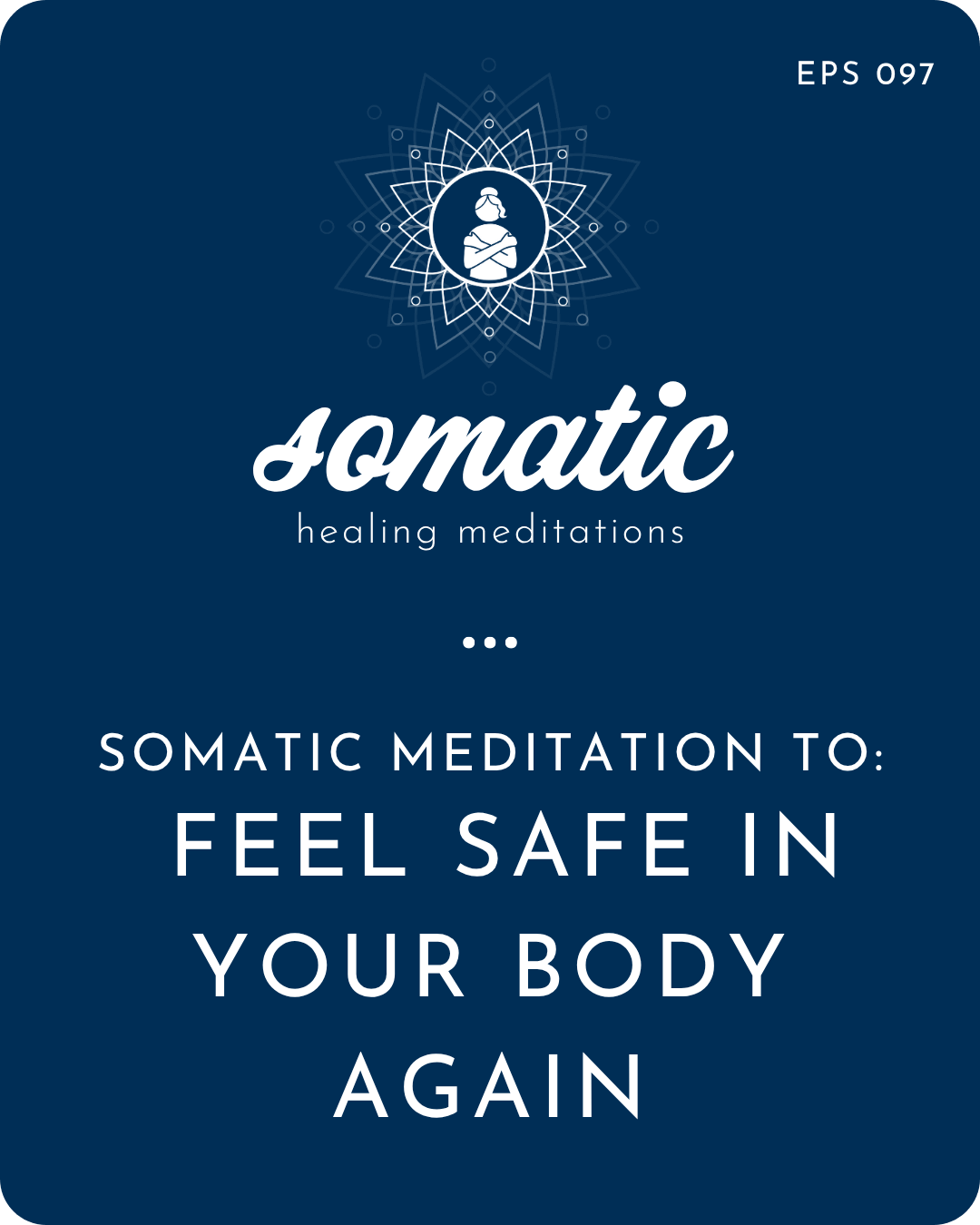Feel Safe in Your Body Again | Somatic Meditation to Create Cues of Safety
How To Feel Safe In Your Body Again
So many of us live in bodies that are working hard to protect us. We feel tense, anxious, or restless, and we try to manage it with thoughts — “I shouldn’t feel this way,” “I just need to calm down,” “I have nothing to be stressed about.”
But safety isn’t something we can think our way into. It’s something the body has to feel.
Most of the time, our sense of safety or threat isn’t even conscious. It lives deep in the nervous system, beneath words and reasoning, in the parts of the brain that are always scanning for danger. This process, known as neuroception in Polyvagal Theory, is constantly reading subtle cues from the world around us and from within us: the tone of someone’s voice, the tension in a room, the speed of your own heartbeat, the memory of something that once hurt.
When these deeper systems sense safety, your body opens. Breath deepens, muscles soften, thoughts slow, connection feels possible again. But when your nervous system perceives threat (even if the danger isn’t actually there anymore), your body responds as if it is. The old protective pathways light up, preparing you to fight, flee, or shut down.
You might call it anxiety, irritability, or emotional overwhelm, but underneath those experiences, what’s really happening is that your nervous system no longer feels safe.
When we’ve lived through prolonged stress or trauma, this threat-detection system can become miscalibrated. It starts to interpret neutral or even pleasant experiences as dangerous. The body isn’t broken, it’s just doing what it learned to do to keep you safe. Healing begins when we start to show the body that it’s safe to relax again.
Nervous System Regulation and Feeling Safe
Your body’s first priority isn’t happiness or productivity … it’s survival. So even when you’re trying to rest, meditate, or connect with others, your nervous system might still be looping in old protective patterns.
When this happens, it’s not because you’re doing something wrong. It’s because the parts of your brain responsible for regulation (especially the ventral vagal system, which supports calm, connection, and social engagement) can’t fully activate when deeper structures, like the amygdala or brainstem, are still sounding the alarm.
This is why you might feel like no amount of positive thinking, breathwork, or meditation is working. You may be trying to regulate from the top down (through the mind) when what’s needed is to regulate from the bottom up (through the body).
When the nervous system begins to downshift from hypervigilance into safety, everything changes. Your thoughts become clearer, your emotions feel more manageable, and your capacity for connection expands.
And this isn’t just psychological, it’s physiological too. Healing happens when the body starts to believe that it’s safe.
And because the nervous system learns through repetition and experience, not logic, it takes consistent, gentle practice to help the body begin to trust that safety is real.
Creating Cues of Safety
One of the gentlest and most effective ways to help the body learn that safety is possible again is by consciously creating cues of safety, small, sensory experiences that signal to your nervous system, “You’re safe enough right now to soften.”
These cues can come from your environment: the warmth in someone’s voice, natural light filtering through a window, soft music, the feeling of your pet’s fur, or the slow rhythm of your own footsteps.
They can also come from within: a longer exhale, the gentle rhythm of Havening touch, the soothing sound of your own voice humming or sighing, or the simple act of noticing the ground supporting you.
Every time you offer your body one of these cues, you’re sending new sensory information to the parts of the brain that regulate safety and threat. You’re essentially giving your nervous system evidence that, in this moment, it’s okay to let go just a little.
With practice, these moments begin to add up. The body slowly starts to reorganize around a new truth: that safety isn’t something rare or fleeting, it’s something you can cultivate from within, moment by moment, breath by breath.
And this is what we’ll explore in today’s somatic meditation. Using Havening touch, gentle orienting, and sensory awareness, we’ll create a series of cues of safety to help your body begin to feel the calm and connection your mind has been longing for.
Somatic Meditation to Create Cues of Safety
In today’s guided somatic meditation, we’ll put these ideas into practice. You’ll learn how to create cues of safety through gentle, body-centered techniques that speak directly to the parts of your nervous system responsible for regulation and calm.
This meditation combines Havening touch, orienting, and other soothing regulation techniques to help you reintroduce safety - slowly, gently, and experientially.
Havening’s soothing touch sends calming signals through the skin to the brain, lowering amygdala activity and producing the same delta brain waves associated with deep rest. Orienting, on the other hand, helps your nervous system recognize that your environment is safe in the present moment. Together, these practices begin to settle the body’s protective patterns and create a felt sense of calm and connection.
As you move through the meditation, notice how your body responds. There’s no need to force anything or make yourself relax. Just bring gentle curiosity to the sensations, images, or emotions that arise. Even subtle shifts, like a deeper breath, softened muscles, or a quiet sigh, are signs that your nervous system is beginning to recalibrate.
The goal of this meditation isn’t to “achieve” safety; it’s to offer your body the conditions where safety becomes natural. Over time, these moments of safety begin to accumulate, creating new neural pathways of trust and ease.
Try this Somatic Meditation to Create Cues of Safety now!
Episode timing:
00:00 - How to Create Cues of Safety to Heal Your Nervous System
07:45 - Somatic Meditation to Create Cues of Safety - How to do Havening touch
10:23 - Somatic Meditation to Create Cues of Safety - Havening and Orienting
19:09 - Somatic Meditation to Create Cues of Safety - Squeeze and Sigh
25:16 - Somatic Meditation to Create Cues of Safety - Noticing Cues of Safety Within and Around Us
33:00 - Conclusion
Learn more about Havening Techniques and the science behind them
Related: find more nervous system healing meditations here
Read more about safety cues and how to feel safe in your body here
Havening Techniques® is a registered trademark of Ronald Ruden, 15 East 91st Street, New York. www.havening.org
How did that Somatic Meditation to Create Safety Cues feel?
How do you feel now? And what was your favorite part?
Please let me know in the comments!
➡️ If you enjoyed this episode, I would love it if you would subscribe, rate, and review this podcast!
And please join me every Friday on this beautiful journey out of your head, and into your more embodied and authentic self. 🩷🩷🩷
Thanks so much for joining me today!
Subscribe, Rate and Review: Apple | Spotify
Enjoy more like this: Havening Exercises, Regulation Exercises
About me
Hey, I’m Karena!
I’m a somatic emotional healing coach here to help you quickly identify and heal the subconscious blocks, old emotional wounds and self-sabotaging core beliefs that are holding you back!
Want to go deeper? Sign up for my free upcoming training The Secret Wisdom of Your Triggers
Uncover the subconscious roots of your triggers + learn a new paradigm of emotional healing!
AND




